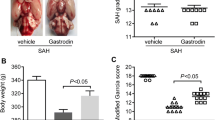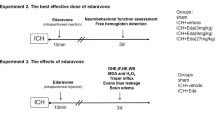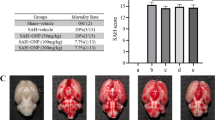Abstract
This study investigates the effect of polydatin on the neurological function of cerebral hemorrhage rats and on the Nrf2 pathway of the endogenous antioxidant system in tissues around cerebral hematoma. Further, the study also aims to provide solid insights for clinical diagnosis and treatment. A total of 54 SPF grade male Wistar rats were divided into three groups: the sham group, model group, and polydatin group. Various parameters such as neurological deficit score, brain water content, pathological morphology, oxidative stress index content, Nrf2, NQO1, HO-1 mRNA expression, and the expression of HO-1, Nrf2, and kelch-like epichlorohydrin-1 (Keap1) protein were observed. Compared with the sham group, the mNSS score and brain water content of rats in the model group increased significantly after dosing (P < 0.05). When compared with the model group, the mNSS score and brain water content of rats in the polydatin group decreased significantly after dosing (P < 0.05). Compared with the other group, the serum NSE content of rats in the polydatin group decreased (P < 0.05). An increase was observed in the contents of NO, SOD, MDA, GSSG, and GSH in the brain tissue of rats in the model group when compared with the sham group. Compared with the model group, the contents of NO and MDA in the brain tissue of rats in the polydatin group decreased, while the contents of SOD, GSSG, and GSH increased (P < 0.05). The relative expressions of Nrf2, NQO1, and HO-1mRNA in the brain tissue of rats in the polydatin group was relatively high compared with both groups (P < 0.05). Polydatin can improve the neurological function of ICH rats and reduce the oxidative stress response by regulating the Nrf2-ARE pathway and downstream gene expression. This study preliminarily discussed the relevant mechanism of polydatin in the treatment of ICH rats, thus providing a theoretical reference to ICH treatment.


Similar content being viewed by others
References
Dai C, Liu Y, Dong Z (2017) Tanshinone I alleviates motor and cognitive impairments via suppressing oxidative stress in the neonatal rats after hypoxic-ischemic brain damage. Molecular Brain 10(1):52
Dong M, Ding W, Liao Y, Liu Y, Yan D, Zhang Y et al (2015) Polydatin prevents hypertrophy in phenylephrine induced neonatal mouse cardiomyocytes and pressure-overload mouse models. Eur J Pharmacol 746:186–197
Fizazi K, Cojean I, Pignon JP, Rixe O, Gatineau M, Hadef S et al (1998) Normal serum neuron specific enolase (NSE) value after the first cycle of chemotherapy: an early predictor of complete response and survival in patients with small cell lung carcinoma. Cancer 82(6):1049–1055
Guo F Q, Xu Y C, Chen L Y, et al. (2008) The relationship between the aquaporin-4 and brain edema, pathologic change, ultrastructure in peri-hematoma tissue in patients with intracerebral hemorrhage. 20(11):674–677
Hui H, Zhao Y, Chen X et al (2007) Quantitative determination of trans-polydatin, a natural strong anti-oxidative compound, in rat plasma and cellular environment of a human colon adenocarcinoma cell line for pharmacokinetic studies. J Chromatogr B Analyt Technol Biomed Life Sci 855(2):145–151
Izaskun B, Michalska P, Navarro E et al (2016) Nrf2-ARE pathway: an emerging target against oxidative stress and neuroinflammation in neurodegenerative diseases. Pharmacol Ther 157:84–104
Jing-Jing Cui, Dong Wang, Fei Gao et al (2012) Effects of atorvastatin on pathological changes in brain tissue and plasma MMP-9 in rats with intracerebral hemorrhage. 62(1):87–90
Jayatilake GS, Jayasuriya H, Lee E-S (1993) Kinase inhibitors from Polygonum cuspidatum. J Nat Prod 56(10):1805–1810
Lanzilli G, Cottarelli A, Nicotera G et al (2012) Anti-inflammatory effect of resveratrol and polydatin by in vitro, IL-17 modulation. 35(1):240–248
Liang L, Gao C, Luo M, Wang W, Zhao C, Zu Y et al (2013) Dihydroquercetin (DHQ) induced HO-1 and NQO1 expression against oxidative stress through the Nrf2-dependent antioxidant pathway. J Agric Food Chem 61(11):2755–2761
Lanfranconi S (2013) Genetics of cerebral hemorrhage and microbleeds. Panminerva Med 55(1):11–28
Lamers KJB, Vos P, Verbeek MM et al (2003) Protein S-100B, neuron-specific enolase (NSE), myelin basic protein (MBP) and glial fibrillary acidic protein (GFAP) in cerebrospinal fluid (CSF) and blood of neurological patients. Brain Res Bull 61(3):261–264
Run-Ping L, Wang Z-Z, Sun M-X et al (2012) Polydatin protects learning and memory impairments in a rat model of vascular dementia. Phytomedicine 19(8–9):0–0
Shibayama T, Ueoka H, Nishii K et al (2001) Complementary roles of pro-gastrin-releasing peptide (ProGRP) and neuron specific enolase (NSE) in diagnosis and prognosis of small-cell lung cancer (SCLC). Lung Cancer 32(1):61–69
Wu M, Meixia L, Guo G et al (2015) Polydatin inhibits formation of macrophage-derived foam cells. Evid Based Complement Alternat Med 2015:1–8
Wang X, Vaccari J P D R, Wang H et al (2012) Activation of the nuclear factor E2-related factor 2/antioxidant response element pathway is neuroprotective after spinal cord injury. J Neurotrauma 29(5):936–945
Xu D, Hu L, Xia X, Song J, Li L, Song E et al (2014) Tetrachlorobenzoquinone induces acute liver injury, up-regulates HO-1 and NQO1 expression in mice model: the protective role of chlorogenic acid. Environ Toxicol Pharmacol 37(3):1212–1220
Yao J, Wang J-Y, Liu L et al (2011) Polydatin ameliorates DSS-induced colitis in mice through inhibition of nuclear factor-kappaB activation. Planta Med 77(05):421–427
Author information
Authors and Affiliations
Corresponding authors
Additional information
Publisher’s Note
Springer Nature remains neutral with regard to jurisdictional claims in published maps and institutional affiliations.
Rights and permissions
About this article
Cite this article
Zhao, X., Qin, J., Li, H. et al. Effect of Polydatin on Neurological Function and the Nrf2 Pathway during Intracerebral Hemorrhage. J Mol Neurosci 70, 1332–1337 (2020). https://doi.org/10.1007/s12031-020-01546-3
Received:
Accepted:
Published:
Issue Date:
DOI: https://doi.org/10.1007/s12031-020-01546-3




